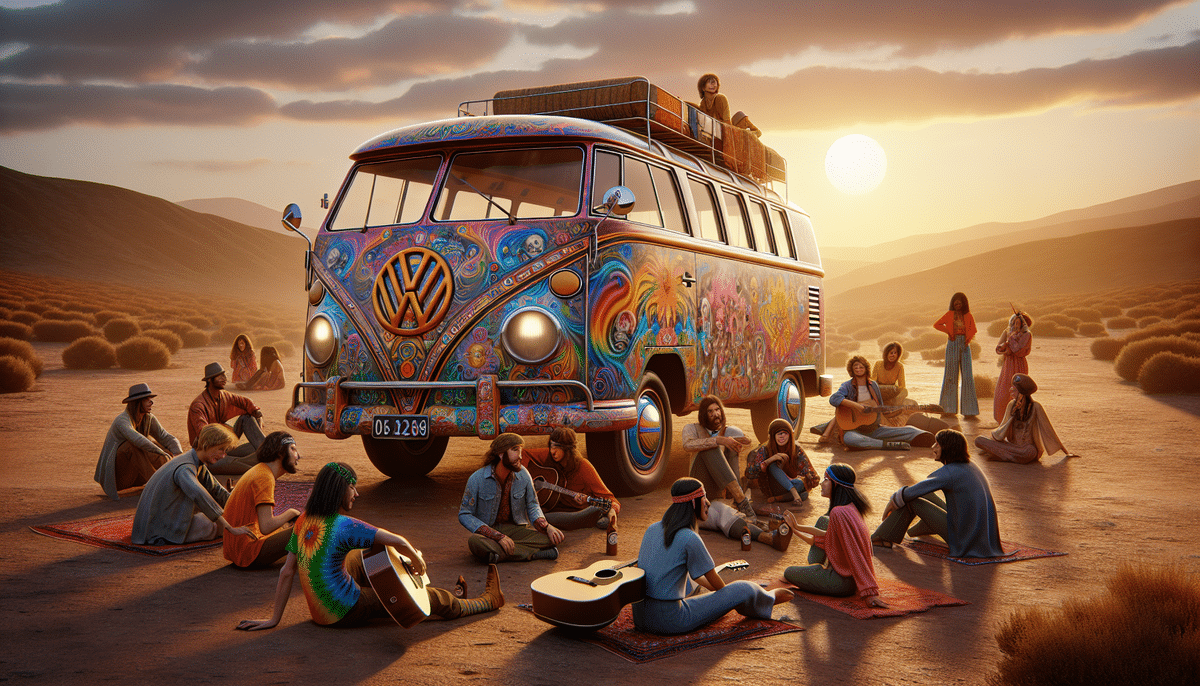In the 1960s and 70s, the Grateful Dead emerged as one of the most influential bands of their time. Their music and live performances were unlike anything seen before and quickly created a devoted fanbase that became known as Deadheads. In this article, we will explore the rise and fall of the Grateful Dead's Deadhead culture and examine its impact on music and American society.
How the Grateful Dead's music and culture gave birth to Deadhead following
When the Grateful Dead first began playing music together, they drew inspiration from folk, blues, and psychedelic rock. Their unique sound, which blended these genres, quickly won over fans. The band's live performances were also a major draw for fans, as each show was unique and unpredictable. The Grateful Dead's music was more than just entertainment; it was a vehicle for personal transformation and spiritual exploration. The band's focus on improvisation and spontaneity led to a deep connection between the musicians and their audience.
As the Grateful Dead's popularity grew, so did the community of fans known as Deadheads. These fans were known for their devotion to the band and their unique culture, which included tie-dye clothing, a love of psychedelic drugs, and a commitment to living a free-spirited lifestyle. Deadheads often followed the band on tour, attending multiple shows and forming close bonds with other fans.
The Grateful Dead's music and culture continue to influence generations of fans and musicians. The band's commitment to improvisation and experimentation has inspired countless artists to push the boundaries of their own music. The Deadhead community also lives on, with fans continuing to gather at festivals and concerts to celebrate the band's legacy and connect with like-minded individuals.
Understanding the significance of the Deadhead culture in the 60s and 70s
The counterculture of the 1960s and 70s was characterized by a rejection of mainstream values and a desire for radical change. The Deadhead culture embodied this spirit, as fans of the Grateful Dead often sought refuge in a community that emphasized alternative values such as communal living, sharing of resources, and free expression. Deadheads were also known for their use of psychedelic drugs, which were seen as a way to access higher states of consciousness and connect with a larger spiritual reality.
Furthermore, the Deadhead culture was also known for its emphasis on live music and the experience of attending concerts. The Grateful Dead were famous for their improvisational style and each concert was a unique experience, with the band often playing for hours on end. Deadheads would follow the band on tour, creating a sense of community and camaraderie among fans. The Deadhead culture also had a significant impact on the music industry, as the band's unconventional approach to music and touring paved the way for other artists to experiment with new forms of expression.
The evolution of Deadhead culture from a small group of fans to a massive following
As the Grateful Dead continued to tour and release new music, their fanbase grew rapidly. Soon, Deadheads were a ubiquitous presence at the band's shows, and their influence began to extend beyond the concert hall. Communities of Deadheads began to form across the country, with many fans living in communal houses and sharing resources. The Grateful Dead also encouraged this sense of community by allowing fans to record their live performances and distribute the tapes freely.
As the Deadhead culture continued to grow, it began to attract criticism from some quarters. Some critics accused Deadheads of being drug-addled hippies with no sense of responsibility or direction. However, many Deadheads saw their culture as a rejection of mainstream values and a celebration of individuality and freedom.
Despite the death of Jerry Garcia in 1995 and the subsequent dissolution of the Grateful Dead, the Deadhead culture has continued to thrive. Many former Deadheads have gone on to become successful musicians, artists, and entrepreneurs, and the sense of community and shared values that characterized the culture remains strong to this day.
The impact of the Grateful Dead's live performances on Deadhead culture
The Grateful Dead's live performances were the cornerstone of Deadhead culture. Each concert was unique and featured the band's signature improvisational style. Fans would often travel long distances to see the band perform, and many attended multiple shows on a single tour. The band's concerts were more than just music performances; they were communal gatherings where fans could connect with one another and share in a common experience.
Furthermore, the Grateful Dead's live performances were known for their psychedelic light shows and intricate stage setups. The band's use of innovative technology and visual effects added to the overall experience and created a sense of awe and wonder among fans. The band's commitment to creating a unique and immersive experience for their fans helped to solidify their place in music history and cemented their status as one of the most influential bands of all time.
The role of psychedelic drugs in shaping Deadhead culture
Psychedelic drugs played a significant role in shaping Deadhead culture. Fans often used drugs such as LSD and psilocybin to enhance their music experience and to explore alternative states of consciousness. The Grateful Dead's music was often described as "trippy" or "psychedelic," and their concerts were seen as a space where fans could freely and safely experiment with these substances.
However, the use of psychedelic drugs also had its downsides. Some fans became addicted to these substances and struggled with addiction and mental health issues. The band members themselves also faced challenges with drug use, with lead guitarist Jerry Garcia struggling with heroin addiction for many years.
Despite these challenges, the influence of psychedelic drugs on Deadhead culture cannot be denied. The band's music and message of peace, love, and unity resonated with fans who were seeking a sense of community and belonging. Today, the legacy of the Grateful Dead and their connection to psychedelic culture continues to inspire new generations of fans and musicians.
The influence of Jerry Garcia on the Grateful Dead's music and the Deadhead community
Jerry Garcia was the heart and soul of the Grateful Dead. As lead guitarist, he was responsible for much of the band's signature sound. Garcia was also a charismatic figure who inspired deep devotion among fans. His early death in 1995 was a significant blow to the Deadhead community, as it marked the end of an era.
Despite his untimely death, Jerry Garcia's influence on the Grateful Dead's music and the Deadhead community continues to be felt today. His unique guitar playing style, which blended elements of rock, blues, and jazz, has inspired countless musicians and continues to be studied and emulated. Additionally, the Deadhead community, which formed around the band's music and ethos, remains a vibrant and active subculture, with fans continuing to gather at concerts and festivals to celebrate the music and legacy of Jerry Garcia and the Grateful Dead.
The role of bootleg recordings in spreading the Grateful Dead's music and building the Deadhead community
The Grateful Dead encouraged fans to record their live performances and trade the tapes. This led to the spread of the band's music and the growth of the Deadhead community. Bootleg recordings were exchanged among fans and helped to create a sense of shared culture and history.
Furthermore, the band's policy of allowing fans to record their shows also had a significant impact on the music industry. It challenged the traditional model of music distribution and paved the way for the modern live music industry. The Grateful Dead's approach to bootleg recordings was a precursor to the current trend of live streaming concerts and releasing official recordings of live performances.
The rise of commercialization and commodification of the Grateful Dead's music and merchandise
As the Grateful Dead's popularity grew, so did their commercial appeal. The band's music was increasingly marketed to a mainstream audience, and their merchandise became a lucrative business. This created tension within the Deadhead community, as many fans felt that the band's values were being compromised in the pursuit of profit.
How changes in the Grateful Dead's music affected the dynamics of the Deadhead community
The Grateful Dead's music underwent significant changes over the years, as the band experimented with new sounds and styles. These changes affected the dynamics of the Deadhead community, as fans responded differently to each new phase of the band's music. Some fans embraced the changes, while others felt that the band had lost touch with their original values.
The decline and eventual dissolution of the Grateful Dead and its impact on the Deadhead culture
By the 1990s, the Grateful Dead had reached the height of their popularity. However, internal tensions within the band led to their decline and eventual dissolution. This had a significant impact on the Deadhead culture, as fans were left without their beloved band. However, the spirit of Deadhead culture continued on, with tribute bands and festivals keeping the music and values alive.
Contemporary manifestations of the Deadhead culture, including tribute bands and festivals
Despite the Grateful Dead's dissolution, the spirit of Deadhead culture lives on. Tribute bands and festivals allow fans to continue to connect with the music and values of the band. These modern-day manifestations of Deadhead culture serve as a reminder of the power of music to inspire and unite people.
How modern-day fans keep alive the spirit of Deadhead culture through online communities
With the rise of the internet, Deadhead culture has found new life in online communities. Fans from around the world can connect and share their love of the Grateful Dead. These online communities serve as a space for fans to discuss the band's music, share stories, and keep the spirit of Deadhead culture alive.
An analysis of how Grateful dead music continues to influence contemporary artists across genres
The Grateful Dead's music continues to have a profound influence on contemporary artists across genres. Many musicians cite the band as a major inspiration, and their music has been covered by a diverse range of artists. The Grateful Dead's legacy continues to shape the landscape of American music.
Reflections on how counterculture movements such as deadheads continue to shape American society today
The Deadhead culture was part of a larger counterculture movement that sought to challenge mainstream values and create a more egalitarian society. While the specific values and goals of the Deadhead culture may have changed over time, their influence continues to be felt in American society today. The spirit of radical transformation that inspired Deadheads still resonates with many people as they seek to create a better world.
In conclusion, the rise and fall of the Grateful Dead's Deadhead culture is a testament to the enduring power of music to inspire and unite people. While the band may be gone, their music and legacy continue to live on through the fans and communities they inspired.





















